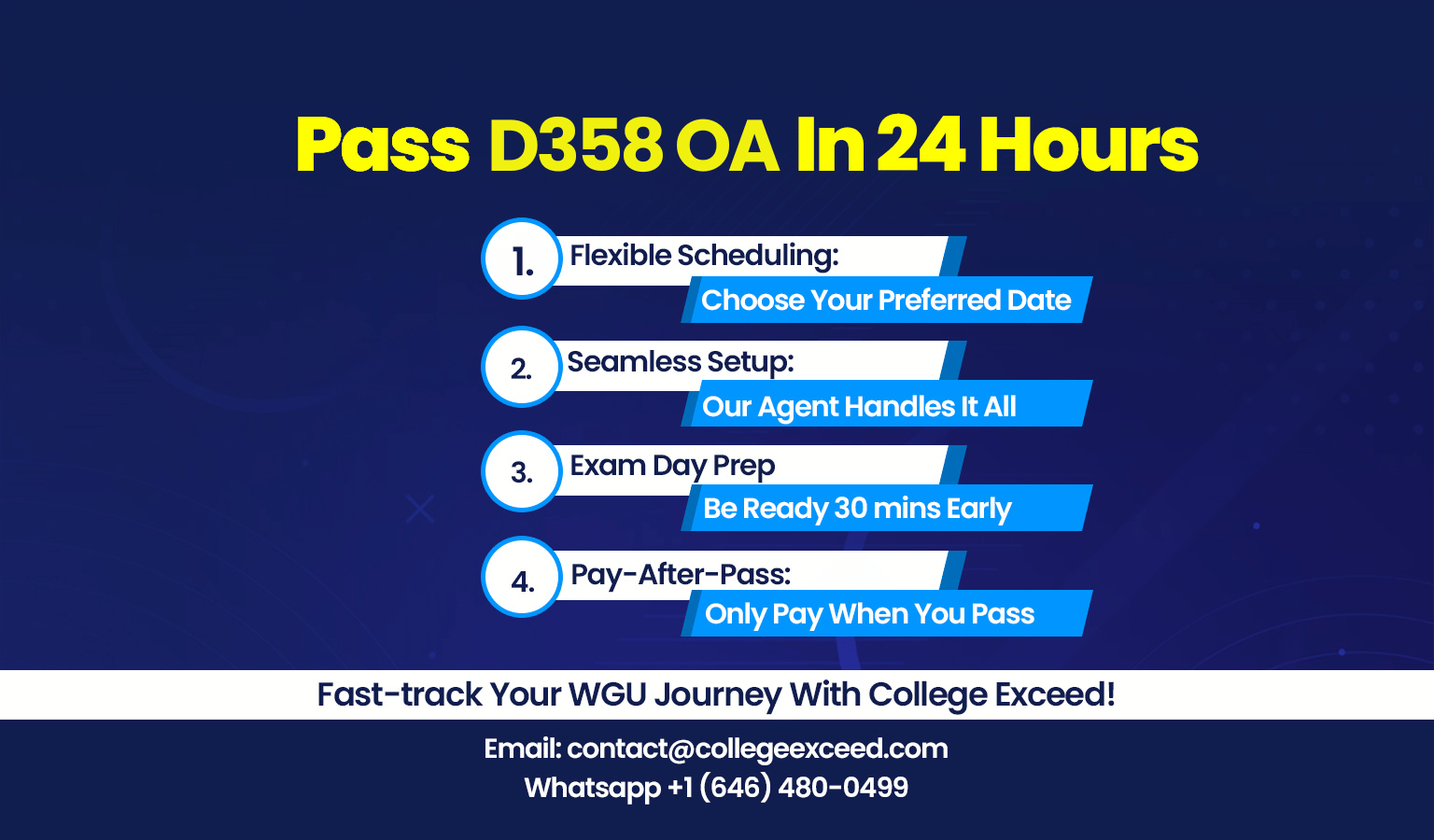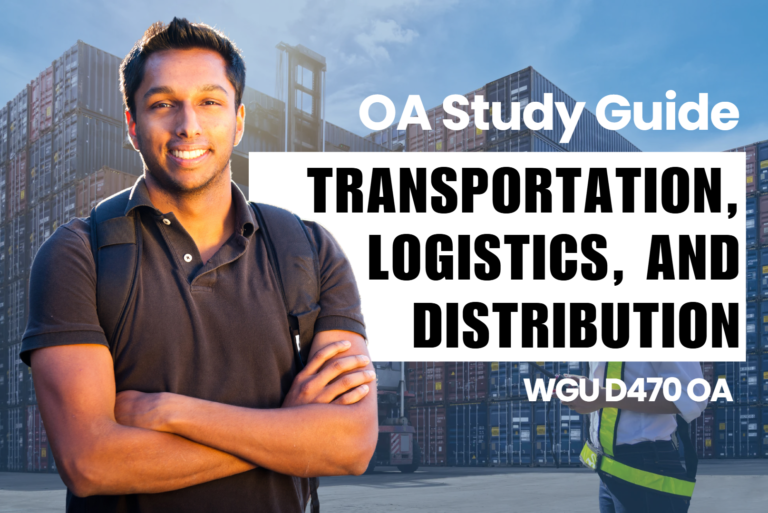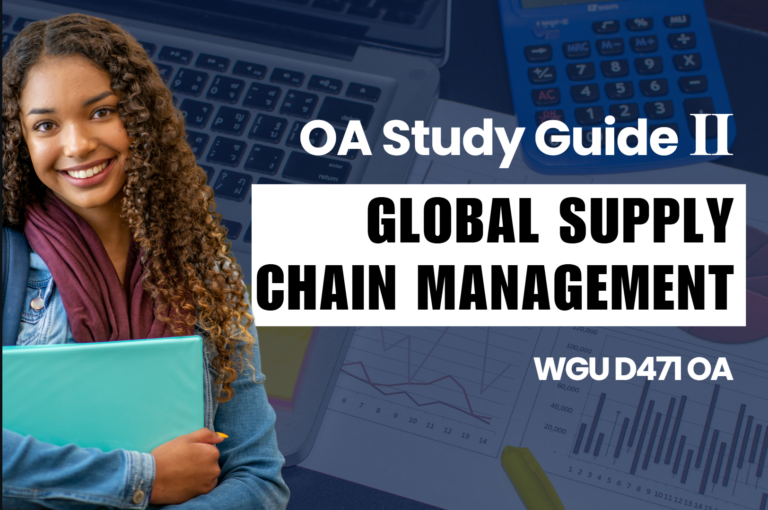WGU D358 OA Study Guide - 2025 | A Guide to International Workforce Management 📖
Managing international operations through several countries challenges businesses like playing with a difficult puzzle game. Every part of our international business activities must mesh together seamlessly including our Tokyo hires and German labor law requirements. But fear not! We help manage international workforce planning issues alongside distinct labor rules and HR platforms. Join us in exploring all aspects of WGU D358 principles without habitual business terminology.
We’ll explore three core pillars of global HR management, making even the trickiest topics feel like a breeze:
- Workforce Planning, Recruitment, and Selection: Your dream team will come to life while following global logistics and cultural requirements. Our steps show you how companies succeed with proper strategies when they face talent shortages and pick their staffing models.
- International Employment Laws and Labor Standards: This is where we learn to play by the rules—and there are a lot of them when you operate across borders! We’ll break down labor standards and explain how they influence local employment laws, all while making it digestible (and maybe even fun).
- International HR Information Systems (HRIS): Finally, we’ll demystify the tech side of HR. Think of HRIS as your organizational superpower, helping businesses manage their global workforce with efficiency and compliance.
Whether you’re preparing for your WGU D358 OA questions or just want to build your expertise in global HR, this article is here to guide you through the maze. Let’s make global HR management simple, engaging, and maybe—just maybe—a little fun.
How to Use This Guide for the WGU D358 OA Exam?📝
The D358 Global HR Management OA exam at WGU evaluates your understanding of global HR practices, international labor laws, and HR technology systems. This guide simplifies the key concepts of international workforce planning, staffing, recruitment, and selection, international employment laws and labor standards, and international HRIS to help you grasp the topics tested in the exam.
We also provide exam-style questions and practical applications to ensure you’re fully prepared for the questions on the WGU D358 OA exam.

International Workforce Planning, Staffing, Recruitment, and Selection For D358 OA📝
In today’s interconnected world, organizations often operate across multiple countries, requiring them to manage diverse teams spread across the globe. International workforce planning, staffing, recruitment, and selection are vital elements in global HR management, ensuring that the right people are in the right roles to support organizational goals. Let’s break down these concepts step by step.
What is International Workforce Planning?
Organizations use forecasts of global labor requirements and develop strategies to obtain the employee talent they need everywhere on Earth.
Why is it important? A company setting up operations in a new nation needs international workforce planning and strategy development. Without a formal plan, they face difficulties in hiring staff and following local employment regulations while maintaining their business goals. Workforce planning helps avoid these issues by proactively addressing:
- Economic Conditions: Companies need to see how economic changes including inflation rates and unemployment figures alongside changes in Gross Domestic Product impact their workforce requirements across many nations.
- Political Stability: Governing systems that don’t change often make countries better for company expansion and worker recruitment.
- Cultural Differences: Understanding cultural standards drives workplace standards and employee expectations at work.
- Legal Regulations: Our team follows all labor rules and employee standards in every nation we serve.
Workforce planning connects an organization’s employee strategy to its business targets so that it can handle changing international market conditions.
Types of Staffing Models
When it comes to staffing, organizations often choose from three primary models based on their global strategy:
- Ethnocentric: Home country nationals fill key positions. This approach ensures consistency but may overlook local expertise.
- Polycentric: Host country nationals are employed for local positions. This model respects local cultures but may create communication barriers with headquarters.
- Geocentric: The best candidates are selected regardless of nationality. This approach is ideal for fostering innovation but can be expensive and complex to implement.
Each model has its pros and cons, and organizations often combine elements of all three to create a hybrid approach tailored to their specific needs.
Recruitment Strategies in a Global Context
Finding the perfect people to fill vacant positions is what recruitment means. When hiring internationally, companies adopt strategies to address diverse challenges:
- Internal vs. External Recruitment: Organizations can pick from their existing staff members (internal recruitment) or search the market for new hires (external recruitment).
- Online Platforms and Social Media: LinkedIn and local job boards help companies discover their new workforce candidates.
- Cultural Considerations: Recruitment strategies must account for regional customs. For instance, while direct communication might be valued in the U.S., indirect approaches may work better in Japan.
- Partnerships: Collaborating with local educational institutions and attending job fairs can help build a talent pipeline.
The Selection Process
Once candidates are identified, organizations must choose the best fit. This involves:
- Defining Selection Criteria: Clear criteria ensure that candidates align with the role and organizational goals.
- Assessment Methods:
- Structured Interviews: This method makes sure all applicants receive the same evaluation process through common interview inquiries.
- Psychometric Testing: We measure how someone thinks as well as their personality traits and company culture match.
- Assessment Centers: Real situations serve as tests to see how well candidates solve everyday work challenges.
- Legal Compliance: Companies need to select candidates using procedures that follow national labor laws, especially discrimination rules.
Challenges in Global Recruitment and Selection
Recruiting and selecting talent on a global scale isn’t without its difficulties. Key challenges include:
- Cultural Differences: Misunderstandings due to different workplace norms and communication styles.
- Talent Shortages: Certain regions may lack skilled candidates for specific roles.
- Integration of Diverse Workforces: Building cohesive teams despite cultural, language, and time zone differences.
- Legal Complexities: Navigating varying employment laws and compliance requirements.
Overcoming Challenges: Real-World Applications
A multinational tech company shows us how to use this approach when they enter the Indian market. They practice staffing in different business units by recruiting local specialists who know the local market. To hire new staff they team up with famous universities and use LinkedIn tools for virtual hiring events. The company looks for employees who match the customs of local communities while meeting worldwide company standards during hiring.
Using these methods helps the company create its local footprint while connecting its worldwide and regional operations together.
Importance For the D358 OA
Effective international workforce planning, staffing, recruitment, and selection are the backbone of any successful global organization. They help companies navigate the complexities of operating in multiple countries while ensuring they attract and retain the best talent. These processes also align directly with strategic goals, ensuring the organization’s growth and sustainability.
In summary, understanding and applying these concepts prepares students to tackle real-world challenges in global HR management. This is especially critical for excelling in assessments like WGU D358 OA questions and gaining a deeper grasp of WGU D358 concepts.
International Employment Laws and Labor Standards For D358 OA📝
Operating in multiple countries brings with it a unique set of challenges, especially when it comes to understanding and complying with international employment laws and labor standards. These frameworks ensure fair treatment of workers while providing organizations with guidelines for lawful and ethical practices. Let’s explore this topic step by step.
What Are International Employment Laws?
International employment laws establish national standards that control how employers and employees work together globally. These laws define how businesses and employees must work together according to specific employment rules and procedures. Their guidelines help companies follow national rules and help employees while preventing employer risks.
Sources of International Employment Laws
- National Laws: Each country has its own set of labor laws that organizations must follow.
- International Treaties and Conventions: Organizations like the International Labour Organization (ILO) set global benchmarks that influence local laws.
- Trade Agreements: Many international agreements include labor provisions that shape local employment practices.
By understanding these laws, HR professionals can ensure compliance, avoid penalties, and build trust within the workforce.
Labor Standards: The Cornerstone of Fair Practices
Labor standards represent organizational guidelines from the International Labor Organization that promote worldwide worker fairness in work practices. Organizations must follow these standards both as legal requirements and ethical responsibilities they must honor.
Core Labor Standards
- Freedom of Association: Employees have the right to form and join unions.
- Elimination of Forced Labor: Workers cannot be coerced into employment.
- Abolition of Child Labor: Protecting children from exploitation in the workplace.
- Elimination of Discrimination: Ensuring equal opportunities irrespective of gender, race, or religion.
These standards form the foundation for a fair work environment and guide companies in creating inclusive policies.
How International Labor Standards Influence Local Laws
International labor standards act as a benchmark for national governments when formulating local employment laws. Countries that ratify ILO conventions integrate these standards into their legal systems, influencing:
- Minimum Wage Laws: Ensuring fair compensation for workers.
- Working Hours: Setting maximum limits for daily and weekly work hours.
- Safety Regulations: Mandating workplace safety measures.
- Anti-Discrimination Policies: Protecting marginalized groups from bias.
For instance, the adoption of international standards has led to stronger protections for workers in industries prone to exploitation, such as manufacturing and agriculture.
Challenges in Compliance
Setting compliance with worldwide and local workplace standards shows great difficulty. Key challenges include:
- Legal Variations Across Countries: Each country’s specific rules create a big problem making global labor law implementation difficult.
- Cultural Differences: Local traditions shape how people follow and enforce labor regulations.
- Monitoring and Enforcement: Achieving global business rules requires strong control systems coupled with trained employees.
- Dynamic Regulatory Environment: Frequent changes in laws demand continuous updates to policies.
Real-World Example: How Companies Adapt
Consider a global retailer expanding into Europe. To comply with local laws, they:
- Align contracts with European Union labor standards.
- Adopt flexible work schedules to respect regional norms.
- Partner with local HR consultants to navigate complex regulations.
These adaptations not only ensure legal compliance but also build goodwill among local communities and employees.
Recent Trends in Employment Laws
With globalization and technology reshaping the workplace, employment laws are evolving to address new challenges:
- Remote Work Regulations: Setting standards for virtual work arrangements.
- Gig Economy Protections: Ensuring fair treatment for freelance and contract workers.
- Data Privacy Laws: Safeguarding employee information in digital systems.
These trends highlight the need for HR professionals to stay updated and proactive in adapting to changes.
Importance For the D358 OA
Understanding international employment laws and labor standards is critical for any organization operating globally. Compliance ensures ethical practices, legal protection, and a positive reputation. For students, mastering this topic is essential for excelling in assessments like WGU D358 OA questions and building a strong foundation in global HR management.
By following international employment standards organizations can protect workers while creating responsible and sustainable operations. These industry standards will guide work trends as globalization changes.
Tired of reading blog articles?
Let’s Watch Our Free WGU D358 Practice Questions Video Below!

International Employment Laws and Labor Standards For D358 OA📝
As businesses expand globally, managing a diverse workforce across multiple regions becomes increasingly complex. This is where International Human Resource Information Systems (HRIS) come into play. Let’s explore how these systems revolutionize global HR practices, step by step.
What is HRIS?
HRIS, or Human Resource Information Systems, are software platforms designed to manage and streamline HR processes. International HRIS is specifically tailored for organizations operating in multiple countries, addressing the complexities of global HR management.
Imagine handling payroll for thousands of employees across various time zones and legal systems. A robust HRIS not only simplifies such tasks but also brings efficiency and strategic insight to global HR management.
Key Benefits of HRIS
- Centralized Data Management: A global HRIS system allows organizations to keep all employee data in one unified system so employees can access reliable information quickly and avoid duplicate entries.
- Enhanced Decision-Making: HRIS tools let teams make smart choices based on detailed data results.
- Streamlined Processes: HR teams use automation to do business as usual while they dedicate themselves to creating strategic planning.
Components of an International HRIS
An effective international HRIS integrates several essential components to manage the complexities of global HR operations. These include:
Data Management
A well-structured HRIS handles employee records, payroll details, and benefits administration. For example, it tracks essential data points like employment contracts, performance appraisals, and tax information, ensuring that everything is easily accessible and secure.
Modules
International HRIS includes specialized modules, such as:
- Recruitment: Our system links all regions to process and coordinate job openings with new recruit tracking and new worker setup activities.
- Performance Management: HR teams use our system to check employee performance and find possible improvement targets.
- Training and Development: Coordinating global learning initiatives and tracking progress effectively.
System Integration
Many international HRIS tools link directly to enterprise resource planning (ERP) systems helping other business units. The connection lets different departments work together better and work faster.
Adapting HRIS to a Global Workforce
Managing a multinational workforce requires HRIS systems to address unique global challenges:
Cultural and Legal Adaptations
- Cultural Adaptation: HRIS platforms must respect regional differences, such as public holidays, work schedules, and cultural norms.
- Legal Compliance: These systems help organizations adhere to varying labor laws, such as data privacy regulations under GDPR or region-specific tax laws.
Localization
Localization involves adapting HRIS to reflect local languages, currencies, and business practices. This ensures that employees across the globe find the system user-friendly and relevant.
Implementation of an HRIS
Successful implementation of an international HRIS requires a strategic approach:
- Planning and Assessment: Identify organizational needs and consult stakeholders to choose the right platform.
- Training and User Engagement: Educate employees and HR professionals on using the system to reduce resistance and encourage adoption.
- Ongoing Support: Regular updates, troubleshooting, and user feedback ensure the system remains functional and efficient.
Overcoming Common Challenges
Implementing and managing international HRIS systems comes with unique hurdles, such as:
- Data Security: Ensuring robust protection for sensitive employee information, especially when data is stored in cloud environments.
- Infrastructure Differences: Adapting to technology access disparities across regions.
- Budget Constraints: Balancing implementation costs with long-term efficiency gains.
Trends Shaping International HRIS
Recent innovations are transforming HRIS capabilities globally:
- Cloud-Based Solutions: Enabling remote access and scalability for dynamic workforce needs.
- AI and Analytics: Revolutionizing recruitment, employee engagement, and performance tracking.
- Mobile Accessibility: Supporting remote workers by providing mobile-friendly interfaces.
Real-World Applications
Consider a multinational corporation leveraging a cloud-based HRIS to manage over 50,000 employees across 60 countries. The system facilitates payroll in diverse currencies, complies with regional labor laws, and offers employees a self-service portal for updating personal information. Such a setup streamlines operations, enhances compliance, and improves employee satisfaction.
Importance For the D358 OA
International HRIS serves as a cornerstone for managing global HR processes efficiently. By providing centralized data, automating processes, and ensuring compliance, it empowers organizations to operate seamlessly across borders. For students tackling assessments like WGU D358 OA questions, understanding HRIS equips them with the tools to navigate real-world global HR challenges.
In conclusion, International HRIS not only simplifies the complexity of global workforce management but also drives efficiency and innovation, enabling organizations to thrive in an increasingly interconnected world.
Tired of reading blog articles?
Let’s Watch Our Free WGU D358 Practice Questions Video Below!

Wrapping Up: Mastering Global HR Concepts with WGU D358📄
Congratulations on exploring the key concepts of global HR management! From workforce planning to employment laws and HR systems, these topics are essential not only for excelling in your WGU D358 OA but also for navigating real-world HR challenges.
Each pillar—Workforce Planning, Employment Laws, and HRIS—plays a vital role in shaping successful multinational organizations. Together, they provide the tools to build diverse teams, ensure compliance, and streamline global HR operations.
Take the time to review these concepts and connect them to practical scenarios. A solid grasp of these ideas will boost your confidence and help you ace your assessments. Good luck with the WGU D358 OA and your journey in global HR management—you’ve got this!






